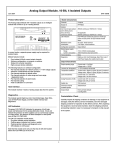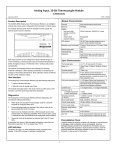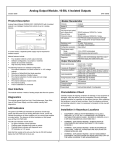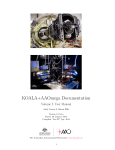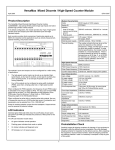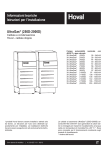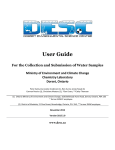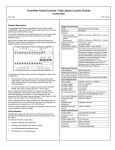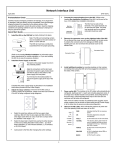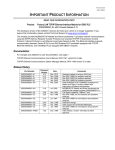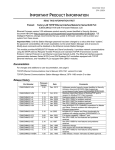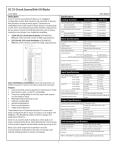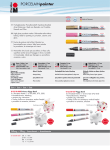Download VersaMax Analog Input, 16-bit Thermocouple Module
Transcript
Analog Input, 16-Bit Thermocouple Module November 2002 GFK-1700D Product Description _________________________________ Module Characteristics The Analog Input Thermocouple Module is an intelligent module that accepts 7 independent thermocouple or millivolt inputs. Channels Module ID The module receives power from the backplane power supply. No external power source is required. Isolation: User input to logic (optical) and to frame ground Group to group Channel to channel OK IND CONT EQ FOR HAZ LOC CLASS I DIV 2 GROUPS ABCD Temp Code T4A Ambient 60C CLASS I ZONE 2 GROUP IIC T4 Ex nA IIC T4 0C≤To≤60C Ex nV II T4 Demko No. 98Y.125014 LED indicators ANALOG INPUT THERMOCOUPLE 1234567 16BIT 7CH Seven thermocouple or millivolt inputs FFFF9804 250VAC continuous; 1500VAC for 1 minute Not applicable None OK LED: Green indicates backplane power is present. Amber indicates module fault. Backplane current consumption 5V output: 125mA maximum. 3.3V output: 125mA maximum. 831 External power supply None Thermal derating Diagnostics None Each input channel can be configured to report millivolts ranges as 1/100 of millivolts, or thermocouple inputs as linearized temperature in tenths of degrees Celsius or Fahrenheit, with or without cold junction compensation. Input Characteristics Open Thermocouple, over/under range, and high/low alarm, thermistor error Thermocouple types J, K, T, S, R, none (used for mV inputs) Spans (+/–) 19.5mV, 39mV, 78.125mV, 156.25mV, 312.5mV, 625mV The module automatically performs A/D calibration at powerup. Automatic calibration is then repeated periodically to compensate for changes in the ambient temperature. New calibration values are filtered into the current calibration values. Converter resolution 15 bits + sign Cold junction compensation Host Interface _______________________________________ If used, reference junction temperature is measured at thermocouple termination using a precision thermistor, or supplied by system, or by fixed configuration value. Cold junction temperature error +/–0.25 degree Celsius (local measurement). To reduce temperature transients, thermocouple terminations should not be installed in the same cabinet as high heat-dissipation assemblies. The Analog Input Thermocouple Module uses the following data types: 7 words of analog input data. 7 optional words of analog output data. The module exchanges data in the same manner as other types of I/O modules: it provides all its input data when requested. Diagnostics _________________________________________ The Analog Input Thermocouple Module performs diagnostics and provides the following information. Alarm faults are reported if the processed value for a channel exceeds its configured alarm limit. Over/underrange faults are reported if the millivolt value for an input exceeds the limits of its span. Open circuit is checked every time a thermocouple input is read (unless Open TC checking is disabled). If the circuit is open, a fault is reported and the input defaults to the configured channel default. Conformity error +/–0.3 degree Celsius, +/–0.5 degree Fahrenheit. Accuracy, at 25° C on voltage measurement: on temp. measurement: +/–0.2% +/- 0.15% Temperature sensitivity (0° to 60°C) +/–0.004% of reading, +/–1.5µV per ° Celsius referred to input Normal mode rejection 60dB, at 50/60 Hz, 100% span Common mode rejection 120 dB at 50/60Hz, 100 ohm imbalance Common mode voltage 3 VDC maximum Maximum voltage between channels 50V Normal mode voltage 5 VDC maximum Scan time 60 Hz: approximately 60 milliseconds per point 50 Hz: approximately 70 milliseconds per point. Preinstallation Check _______________________________ Carefully inspect all shipping containers for damage. If any equipment is damaged, notify the delivery service immediately. Save the damaged shipping container for inspection by the delivery service. After unpacking the equipment, record all serial numbers. Save the shipping containers and packing material in case it is necessary to transport or ship any part of the system. A thermistor fault occurs if the calculated temperature value from the thermistor is less than -10 degrees C or greater than +75 degrees C. LED Indicators ______________________________________ The green OK LED is on when backplane power is present to the module. If this LED is amber, it indicates a module fault. 1 Analog Input, 16-Bit Thermocouple Module November 2002 GFK-1700D Installation Instructions _______________________________ Field Wiring Terminals _____________________________ The terminal assignments shown below are the same for all carriers. The preferred installation technique is to mount the Thermocouple Module on a Connector-style I/O Carrier and connect thermocouples to an Interposing Thermocouple Carrier as shown below. The Interposing Thermocouple-style I/O Carrier provides both box-style wiring terminals and a built-in thermistor for Local Cold Junction Compensation. It connects to the Connector-Style Carrier via a cable as shown. This allows the thermocouple connections to be located away from the I/O modules in the system. Each TC terminal on the Interposing Thermocouple Carrier accommodates one solid or stranded AWG #14 (avg. 2.1mm2 cross section) to AWG #22 (avg. 0.36mm2 cross section) wire, or two wires up to AWG #18 (avg. 0.86mm2 cross section). Number A1 A2 A3 A4 A5 A6 A7 A8 A9 A10 A11 A12 A13 A14 A15 A16 A17 A18 However, it is also possible to mount the Thermocouple Module on one of the terminal-style carriers (box-style, spring-style, or barrierstyle) and provide Local Cold Junction Compensation by using a kit that includes the correct type of thermistor, as described in the I/O Modules User Manual. Both methods are shown below. The thermistor kit must be installed on the A9 and A10 terminals of the carrier. If the module will only be used to measure millivolt inputs, not thermocouple inputs, it can be mounted on any type of I/O Carrier. The thermistor terminals A9 and A10 cannot be used as millivolt input terminals. Connection Channel 1 (+) Channel 1 (-) Channel 2 (+) Channel 2 (-) Channel 3 (+) Channel 3 (-) Channel 4 (+) Channel 4 (-) (Thermistor (+)) (Thermistor (-)) Channel 5 (+) Channel 5 (-) Channel 6 (+) Channel 6 (-) Channel 7 (+) Channel 7 (-) No connection No connection Number B1 B2 B3 B4 B5 B6 B7 B8 B9 B10 B11 B12 B13 B14 B15 B16 B17 B18 Connection No connection Shield No connection Shield No connection Shield No connection Shield No connection Shield No connection Shield No connection Shield No connection No connection No connection No connection Wiring Connections for Carriers with Two Rows of Terminals: Note: only for thermocouple carrier Thermistor AI 1 A 1 AI 2 2 3 AI 3 4 5 AI 5 AI 4 6 7 8 9 10 11 12 AI 6 13 AI 7 14 15 16 17 18 Wiring Connections for Carriers with Three Rows of Terminals: A AI 6 13 AI 7 14 7 16 17 Thermistor AI 4 Thermocouple or Millivolt Inputs 15 8 9 10 18 Note: only for thermocouple carrier AI 5 11 12 Thermocouple or Millivolt Inputs AI 1 Install Optional Thermistors Here 1 AI 2 2 3 AI 3 4 5 6 Cable Shield Connections ___________________________ Shielded twisted pair cable is recommended for the analog channel connections. If possible, the cable should be grounded at the source device. If that is not possible, the cable shield must be grounded at the I/O module. This can be done using an Auxiliary I/O Terminal strip. CHS014 Thermocouple Inputs Built-In Thermistors Located Here If the module is installed on a Terminal-style I/O Carrier, shield connections can be made on an Auxiliary I/O Terminal that is attached to the I/O carrier. Thermocouple Inputs If the module is installed on a Compact Terminal-style I/O Carrier, shield connections can be made on an Auxiliary I/O Terminal that is mounted near the I/O carrier. If the module is installed on a Connector-style I/O Carrier, the cable shield can be connected directly to an Interposing Terminal. A shielded interposing cable (shielded cables are available separately) must be used between the Connector-style I/O Carrier and the Interposing Terminal. An Auxiliary I/O Terminal Strip can also be added to the Interposing Terminal if additional shield connections are required. 2 Analog Input, 16-Bit Thermocouple Module November 2002 GFK-1700D Description of Configurable Features __________________ Product Version Information __________________________ Revision Letters: Firmware version: Firmware upgrades: Channel Active: Each channel can be configured as either active or inactive. If a channel is inactive, the filtering, scaling, calibration, and alarm checks are omitted for that channel, and a value of 0 is returned for the channel. The reference parameter for the analog input data returns the byte length and is independent of the number of active channels. BB 1.01 Not required. Older versions must be upgraded to use all module features. Compatibility ________________________________________ Low Alarm Limit and High Alarm Limit: Each input channel can have a low alarm limit and a high alarm limit. If an input reaches one of its limits, the module reports the actual value and sends the appropriate diagnostic input bit. Alarms do not stop the process or change the value of the input. Alarm limits can be set anywhere over the dynamic range of the signal. The range for each is –32,768 to +32,767. The high alarm limit must be greater than the low alarm limit. If alarm reporting is not wanted, alarm limits can be set beyond the dynamic range of the signal so they will never be activated. This module is compatible with: PLC CPU Firmware version 1.20 or later. Ethernet NIU EBI001 all versions. Genius NIU GBI001 Firmware version 1.10 or later* Profibus NIU PBI001 Firmware version 1.10 or later* DeviceNet NIU DBI001 Firmware version 2.10 or later * For GBI001 and PBI001, NIU version 2.0 or above is required to perform software configuration. Thermocouple Limits: The table below lists millivolt and temperature limits for applicable thermocouple types. Operating Notes _____________________________________ 1. 2. After an Open Circuit fault condition is corrected, the module takes a few seconds to return to normal operation. During this time, the module continues reporting the channel default input value. After the module has recovered from the Open Circuit fault, it returns to normal inputs and normal operation. If there is a very large change in an input (for example, an input quickly goes from 50mV to 400mV), the module may briefly report an Overrange fault on that circuit even though the circuit is not actually over its configured upper range limit. This is only temporary. The default parameters of the Thermocouple Input module can be used in many applications. The module can be software-configured when it is installed in a PLC system, or an I/O Station controlled by an NIUt that supports software configuration, as listed above. Parameter Default Choices 7 1 to 7 user selectable Thermocouple Type Range R J Type Alarm Low Alarm High Reference Junction Value Correction Factor Channel Default Input Cold Junction Default 0 0 to 7 user selectable 60 Hz No 50 Hz, 60 Hz Yes, No Active 1/10 degrees C J 625 Local –2000 8000 250 0 0 250 Inactive (off), Active (on) Millivolts, 1/10 degrees C, 1/10 degrees F Low mV Limit High mV Limit Low Temperature Limit (C) High Temperature Limit (C) J –8.0960 57.9420 –210.00 1000.00 K –5.8910 54.8069 –200.00 1370.00 T –5.6030 20.2520 –200.00 390.00 S –0.1940 18.5040 –40.00 1750.00 R –0.1880 20.8780 –40.00 1750.00 Cold Junction Compensation: The Thermocouple module provides four choices for Cold Junction Compensation. Configurable Features ________________________________ Analog Input Data Length Analog Input Data Reference Analog Output Data Length Analog Output Data Reference Line Frequency Suppress Open Thermocouple Channel Active Engineering Units TC Type No Cold Junction Compensation: This is used for millivolt inputs or if cold junction is maintained at 0 degrees C. Remote Cold Junction Compensation: With this option, cold junction is measured externally and provided to the module from the application, via the module’s analog output (word output) data. If the module has multiple thermocouples that are configured for remote compensation, the same compensation value must be used by each. Fixed Cold Junction Compensation: This option uses a fixed compensation value which is provided as part of the module configuration. Local Cold Junction Compensation: The best way to provide local compensation is with an Interposing Thermocouple Carrier, which has a built-in thermistor. Using an Interposing Carrier allows the thermocouple connections to be placed farther away from the I/O modules in the system, which helps shield thermocouple connections from module heat. If Local Cold Junction Compensation is configured and an Interposing Thermocouple Carrier is not used, a separate thermistor must be installed directly at the module’s I/O Carrier, using the Thermistor (+) and Thermistor (–) terminals. The thermistor must be the type specified in the I/O Modules User’s Manual. Note: If Local Compensation is selected but an Interposing Thermocouple Carrier or local thermistor is not used, erroneous temperatures may be reported and a thermistor error will be reported in the fault table. Range Selection: The module is configurable for any of six different millivolt ranges (+/–): 19.5mV, 39mV, 78.125mV, 156.25mV, 312.5mV, and 625mV. All but the last provide input readings in hundredths of millivolts. For the 625mV range, inputs are in tenths of millivolts. When used to read millivolts, the Thermocouple Type configuration parameter must be set to “none”. None, J, K, T, S, R 19.53, 39.06, 78.125, 156.25, 312.5, 625. Local, Remote, Fixed, None –32,768 to +32,767 –32,768 to +32,767 –32,768 to +32,767 –32,768 to +32,767 +32,767 +32,767 3



